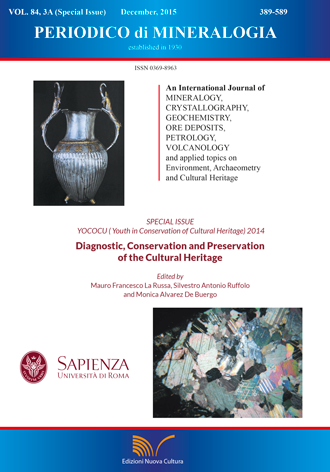LIBS and XRF analysis for a stratigraphic study of pictorial multilayer surfaces
DOI:
https://doi.org/10.2451/2015PM0024Keywords:
Pictorial layers, pigment analysis, mural paintings, X-Ray Fluorescence spectroscopy, Laser induced breakdown spectroscopyAbstract
The study of painting materials is a primary goal for the historical and artistic characterization of works of artbecause it provides useful information about the original materials and their degradation products, the paintingstechnique and any conservation treatments. However, the archaeometric investigations are very complex because theneed to safeguard the Cultural Heritage makes necessary the use of non or micro invasive techniques. Among thepossible analytical approaches, Laser-Induced Breakdown Spectroscopy, supported by X-ray Fluorescencespectroscopy for a faster elements identification, allows stratigraphic analysis with high spatial resolution enough todiscriminate different layers. Moreover, an integrated approach based on XRF and LIBS investigation is particularlyuseful for the complementarities of the outcomes in terms, both of investigated thicknesses and detectable elementalcontent.This paper aims to validate, in the archaeometry field, the use of LIBS for stratigraphic investigation of paintedsurfaces/objects by means of analytical results obtained from original fragments of mural paintings originating fromdifferent sites and artistic eras. Indeed the focus of this work is to determine the optimum parameters for bothtechniques in order to acquire the maximum information with the least damage to the works of art.The results have demonstrated the usefulness of the LIBS investigation, through that it has been possible toreveal chemical elements undetectable by XRF and to analyse the stratigraphic sequence of paint layers from thesurface up to the support layer. Furthermore they have provided good insight into the different painting layers byconfirming the potential of the LIBS to carried out stratigraphic analyses in a micro destructive way.


